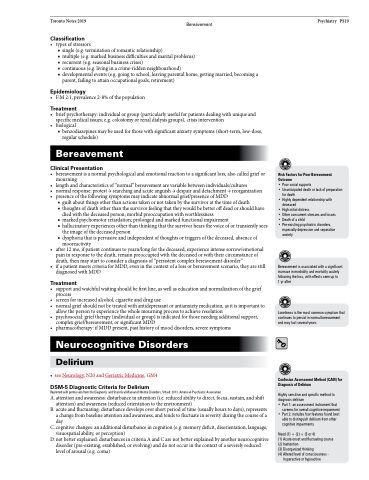Page 1183 - TNFlipTest
P. 1183
Toronto Notes 2019 Bereavement
Classification
• types of stressors
■ single (e.g. termination of romantic relationship)
■ multiple (e.g. marked business difficulties and marital problems)
■ recurrent (e.g. seasonal business crises)
■ continuous (e.g. living in a crime-ridden neighbourhood)
■ developmental events (e.g. going to school, leaving parental home, getting married, becoming a
parent, failing to attain occupational goals, retirement)
Epidemiology
• F:M 2:1, prevalence 2-8% of the population
Treatment
• brief psychotherapy: individual or group (particularly useful for patients dealing with unique and specific medical issues; e.g. colostomy or renal dialysis groups), crisis intervention
• biological
■ benzodiazepines may be used for those with significant anxiety symptoms (short-term, low-dose,
regular schedule)
Bereavement
Clinical Presentation
• bereavement is a normal psychological and emotional reaction to a significant loss, also called grief or mourning
• length and characteristics of “normal” bereavement are variable between individuals/cultures
• normal response: protest → searching and acute anguish → despair and detachment → reorganization
• presence of the following symptoms may indicate abnormal grief/presence of MDD
■ guilt about things other than actions taken or not taken by the survivor at the time of death
■ thoughts of death other than the survivor feeling that they would be better off dead or should have
died with the deceased person; morbid preoccupation with worthlessness
■ marked psychomotor retardation; prolonged and marked functional impairment
■ hallucinatory experiences other than thinking that the survivor hears the voice of or transiently sees
the image of the deceased person
■ dysphoria that is pervasive and independent of thoughts or triggers of the deceased, absence of
mooreactivity
• after 12 mo, if patient continues to yearn/long for the deceased, experience intense sorrow/emotional
pain in response to the death, remain preoccupied with the deceased or with their circumstance of
death, then may start to consider a diagnosis of “persistent complex bereavement disorder”
• if a patient meets criteria for MDD, even in the context of a loss or bereavement scenario, they are still
diagnosed with MDD
Treatment
• support and watchful waiting should be first line, as well as education and normalization of the grief process
• screen for increased alcohol, cigarette and drug use
• normal grief should not be treated with antidepressant or antianxiety medication, as it is important to
allow the person to experience the whole mourning process to achieve resolution
• psychosocial: grief therapy (individual or group) is indicated for those needing additional support,
complex grief/bereavement, or significant MDD
• pharmacotherapy: if MDD present, past history of mood disorders, severe symptoms
Neurocognitive Disorders
Delirium
• seeNeurology,N20andGeriatricMedicine,GM4 DSM-5 Diagnostic Criteria for Delirium
Reprinted with permission from the Diagnostic and Statistical Manual of Mental Disorders, 5th ed. 2013. American Psychiatric Association
A. attention and awareness: disturbance in attention (i.e. reduced ability to direct, focus, sustain, and shift attention) and awareness (reduced orientation to the environment)
B. acute and fluctuating: disturbance develops over short period of time (usually hours to days), represents a change from baseline attention and awareness, and tends to fluctuate in severity during the course of a day
C. cognitive changes: an additional disturbance in cognition (e.g. memory deficit, disorientation, language, visuospatial ability, or perception)
D. not better explained: disturbances in criteria A and C are not better explained by another neurocognitive disorder (pre-existing, established, or evolving) and do not occur in the context of a severely reduced level of arousal (e.g. coma)
Psychiatry PS19
Risk Factors for Poor Bereavement Outcome
• Poor social supports
• Unanticipated death or lack of preparation
for death
• Highly dependent relationship with
deceased
• High initial distress
• Other concurrent stresses and losses • Death of a child
• Pre-existing psychiatric disorders,
especially depression and separation anxiety
Bereavement is associated with a significant increase in morbidity and mortality acutely following the loss, with effects seen up to
1 yr after
Loneliness is the most common symptom that continues to persist in normal bereavement and may last several years
Confusion Assessment Method (CAM) for Diagnosis of Delirium
Highly sensitive and specific method to diagnosis delirium
• Part 1: an assessment instrument that
screens for overall cognitive impairment • Part 2: includes four features found best
able to distinguish delirium from other cognitive impairments
Need(1)+(2)+(3or4)
(1) Acute onset and fluctuating course (2) Inattention
(3) Disorganized thinking
(4) Altered level of consciousness -
hyperactive or hypoactive


